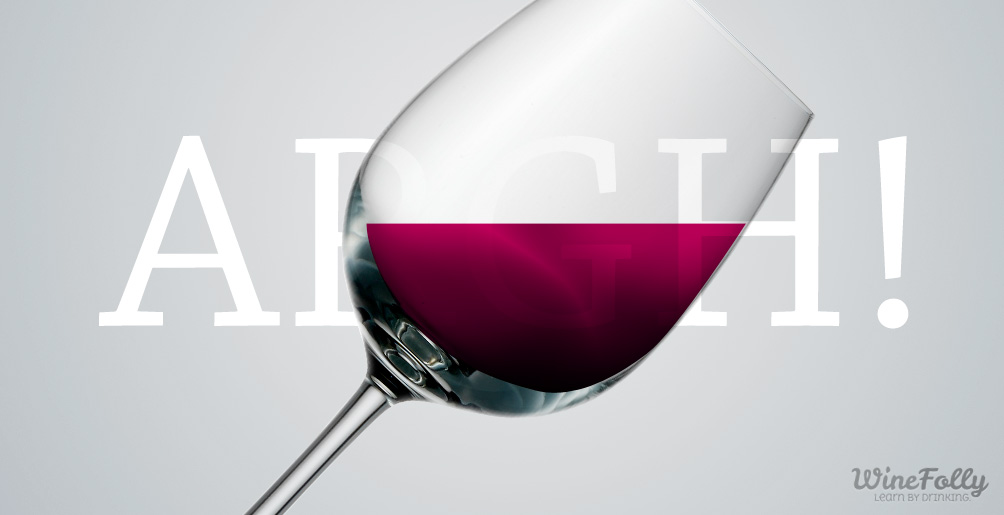Hopefully, you’re here looking for a solution to a problem: a problem with red wine headaches. Luckily, there are only three things you need to do to fix your problem.

Already Have a Wine Headache?
The article below talks about what to do to prevent a wine headache (you can!). However, if you’re already suffering, check out this article instead.
Wine Headaches Suck
I used to get a wine headache, it seemed, with every glass of red wine. As much as I prayed, the infamous Red Wine Headache (RWH) hit me every time. It would start about an hour after I started drinking.
What I didn’t know at the time was that I was making some newbie mistakes.
3 Tricks to Remedy a Wine Headache
#1 Drink a Glass of Water With Every Glass of Wine.
The most common mistake that wine drinkers make is hydration. It’s easy to forget because you are drinking already. When wine is involved, hydration is key, and water is what you need. Please make it a habit to chug a glass of water before you enjoy a glass of wine. It may stress your server out, but your forehead will appreciate you.
#2 Take “Two” Before Drinking.
By ‘two,’ I mean two aspirin, two ibuprofen, or two acetaminophen. This is, of course, at your own risk and not recommended if you drink heavily. That said, over-the-counter blood thinners can help. The pills are also a great way to force yourself to drink a glass of water.
Since I’m mentioning over-the-counter drugs and I’m not your doctor, be sure to consult your doctor first. If you are uncomfortable with this idea (as many are), skip to trick #3 and repeat trick #1.
#3 Don’t Eat Sugary Things with Wine.
The only thing worse than a red wine headache is a cake-and-wine headache. Confetti cake sounds amazing (especially after a glass of wine). However, the combination of sugar and alcohol will greatly exacerbate the potential for a headache. If you are sensitive to wine, reserve confetti cake for your midnight coffee-and-cake binges and stave off the dessert desire while drinking wine.

What Causes a Wine Headache?
When I started drinking wine, I got a lot of headaches. As it turns out, my wine choices (of cheapo grocery store wine) may have contributed to the reaction. Poorly made wines tend to have more adulteration, such as residual sugar, sulfur, fining agents, or higher alcohol, to make them taste better. If it comes from a box or has a critter on the label, then it’s suspect for headache potential.
MYTH: Sulfites in Wine Cause HeadachesIf it comes from a box or has a critter on the label, it’s suspect for headache potential.
In the 1980s, the Food and Drug Administration discovered that about 1% of the population was allergic to sulfites. Because of the health concern for the sensitive population, wines above 20 ppm (parts per million) must be labeled with “contains sulfites.” Sulfites occur naturally on grapes, and small amounts of sulfur are commonly added at the beginning of fermentation and before bottling. Typically, red wines have about 50-350 ppm, and white wines have more, about 250-450 ppm (because of extreme sensitivity to light, heat, and discoloration). The general litmus test for sulfites sensitivity is dried fruit. Dried mangos and apricots contain about 4-10 times as many sulfites as wine (1000-3000 ppm).
FACT: Histamines Cause Inflammation
Dr. Freitag from the Diamond Headache Clinic in Chicago originally wrote an article about how histamines may be the culprit in causing red wine headaches. Foods that have been fermented or aged have higher histamine levels, such as tofu, tempeh, champagne, red wine, ketchup, and aged meats. Histamines can cause inflammatory flushing and wakefulness at night. Since most histamines are a cause of allergic reactions (similar to hay fever), taking an anti-histamine before drinking may solve the problem. An ancient Chinese remedy calls for black or oolong tea to reduce swelling.
THEORY: Sensitivity to Tannins
Tannin is what gives a red wine pigment, bitterness, and that mouth-drying reaction. It also is what makes red wines last a long time. Many red wine headache sufferers blame tannins, as white wines contain far less. The tannin comes from a grape skins, seeds, and stems, as well as from wood. Many commercial wines also add tannins from commercial refined sources made from chestnut, Indian gooseberry, gambir leaf and the wood of a very dense dark-wooded Spanish tree called Quebracho. The problem with the tannin argument is that chocolate, tea, and soy are also all very high in tannin, so it begs the question, “If you do not react to tannin in tea, why would you react to tannin in wine?”
THEORY: Increased Tyramine Levels
As foods age and proteins are broken down, tyramine levels increase. When tyramine (a type of amine) is isolated, it’s been shown to be a major headache-causer for people who suffer from migraines. Tyramine causes the tightening of blood vessels. It’s found in various foods such as aged cheese, cured ham, yogurt, soy sauce, beans, shrimp paste, coconut, yeast, bananas, raspberries, peanuts, pineapple, avocado, eggplant, and others. So, if you are also sensitive to these other foods, this might be the cause. That said, people with consistent exposure to tyramine tend to be affected by it less. So… maybe more consistent wine drinking to overcome the classic RWH?
Don’t be quick to blame wine when you’re not drinking enough water.
NOTE: Allergic Reactions to Alcohol or Yeast
People with heightened sensitivity to alcohol and yeast should be careful with wine because it contains both. Don’t have your wine with hard cheeses and bread (what?!) if you’re trying to keep your yeast intake down. Test your theories carefully, and don’t be quick to blame wine when you’re not drinking enough water.
